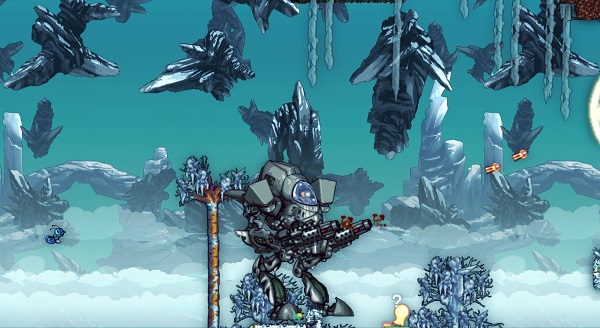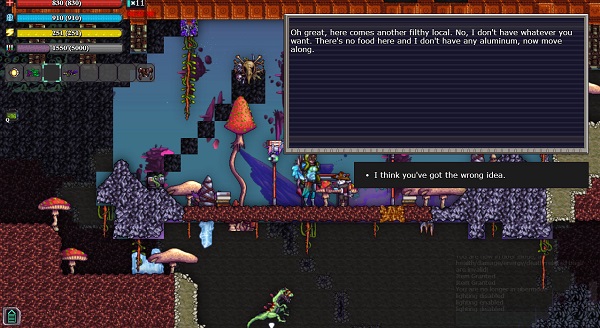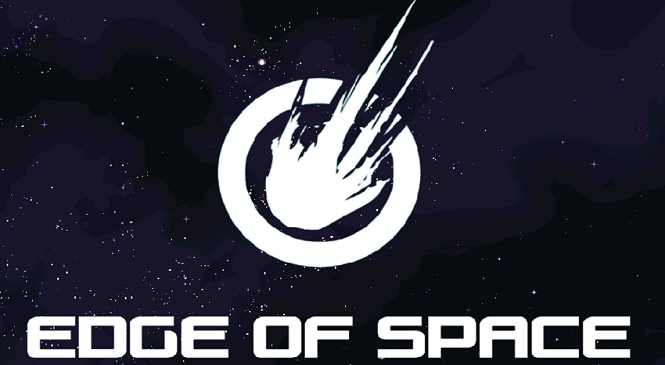SciFi4Me Game Review: Edge of Space
Disclosure: SciFi4Me was given a free copy to review from the developer.
Game: Edge of Space
Platform: PC
Distribution: Steam

From Minecraft to its two-dimensional counterpart, Terraria, the “build your own procedural-generated world” style games have been becoming surprisingly common. Much like how “rouge likes”, “MOBA” (Multiplayer Online Battle Arenas), and “survival horror” genres have started to flood the indy developer pipelines, so too are these “craft-centric” genre games.
Edge of Space is one of these two dimensional procedural-generated craft system games that promotes building and crafting ever increasing crazy scales of buildings, space ships, armor, weapons, space dinosaur mounts, and a whole host of other “things”. Coming out of Steam’s Early Access program to be officially now launched, Edge of Space comes with a lot of bells and whistles, including your very own jet-pack, to aid in your adventure in their floating island space paradise.
After playing it for a few hours, I feel like this game is best broken up into two categories. The categories being “What I liked” and “What I really didn’t like”.
Let’s start with the good things in the game with the first category
What I liked

The Theme
Like Starbound, another extremely similar space themed “build it yourself” game that had been (mostly) released before (though I think it might still be in Steam’s Early Access Program for continual development), Edge of Space is a multi-world exploration game that focuses on mining, building, and fighting monsters… in space. Everything within the world is procedural generated and you must adapt and build things, including weapons, armor, and structures to survive. What’s not to like about that? I did notice that there was some semblance of a story within the game… though it was a little hard to follow with the massive onslaught of the other tutorial “read me” screens.
Some sort of distinct visual separation of “how to play” and “this is the story” would be nice. I did, however, like that the sprite for the first quest giving NPC was a flying shark… though the super high pitched dog-toy squeak every time it dropped a text box at your feet got pretty annoying pretty quickly… to the point where I just started to ignore the shark all together and just explore.
Movement
There are a lot of different ways to get around in Edge of Space. You even start with a jet-pack, which you can constantly upgrade into bigger and better rocket powered flight devices, that lets you zip about this way and that as you dangle precariously between the floating island chunks. And boy, will you have to hope that there’s another island near you each time you take a leap of faith to get to a new area. Your jet pack runs out of fuel quickly, and if there’s nothing below you, you’ll splat or go to the “radiation zone” and be poisoned to death in moments.
Other ways you can get around is by catching a ride on dinosaurs covered in armor and guns, and you can even make big missile launching robots that you can fight in. As long as you are on a flat plane or a large swath of land, you can move about quite freely. It’s once you run out of ground that you start to have great deal of trouble… which happens exceedingly often with the nature of procedural generated environments.
Speaking of procedural generation, my fellow game design students have a fun little saying about “R.N.Jesus” and hoping that you stay within his graces. “May R.N.Jesus be in your favor”. This is a play on the term R.N.G. or “random number generator”, an algorithm that selects a random number out of a range and type of numbers (example would be all rational numbers from a range of 0 to 1). Most procedural generators are based on Random Number Generators where a system generates a large array of random numbers and the numbers dictate what is placed where.

Depth
There is a ton of content and things to do that are stuffed into Edge of Space. Exploring the “help information” and the level up system of the game gave a great deal of insight into just how much there is to discover… and even then, it’s really only scratching the surface. To be honest, I felt kind of lost when the breadth of it really hit me. I didn’t really know what to do first or where to start to get to do what I wanted. I still kind of have no idea how to go about getting raptors with machine guns. One of the hardest part of these kinds of exploratory games is how much knowledge and choice do you give to your players. Judging just how much a player needs to understand and know to really get into a game like this is very difficult. To little, and players become lost. Too much as they get overwhelmed and bored and they get frustrated and stop playing.
A good article to read about giving players choices and the impact choice has on player agency comes from GD Mag (Game Developer’s Magazine).
[su_quote cite=”Soren Johnson, GD Magazine” url=”http://www.gamasutra.com/view/news/197181/When_choice_is_bad_finding_the_sweet_spot_for_player_agency.php”]…because game designers hold choice as such an ideal—with phrases like “enabling player agency” and “abdicating authorship” — its downside is often ignored during development, hiding in a designer’s blind spot. In fact, every time a designer adds more choices to a game, they make a tradeoff.
With every new option added, your game will gain a degree of player engagement, but at the cost of something else. These costs — too much time, too much complexity, or too much repetition — all can far outweigh the positive qualities of the extra choice[/su_quote]
Within the three hours of play that I have been able to devote to the game, I had barely scratched the surface of all the interesting things to do. Content is blocked by a progression tree… though the layout is rather annoying with the 10 or so tabs of stuff you have to scroll through making finding out what you should do next difficult. You are given this massive brochure that displays all of your level up and unlocks at once. Trying to figure out “what I qualify for” vs “what comes later” takes a great deal of time.
Making a plan for leveling up is tough as well, as each new level in a subject comes with unlocks and perks that aren’t really well described in the UI tooltips. Every time I’d level up, I’d have to make sure I was in a safe location, open up my leveling manual, and spend the next 3-5 min trying to figure out “where am I going” and “what do I put points in when to do what I want to do”.
You unlock builds, weapons, and blueprints by spending chunks of experience that you use as kind of a level currency. You gain experience by doing pretty much anything in the game, so content is unlocked as you go at a pretty steady rate. How much experience you can have at one time is capped at 5,000 points at a time… meaning that if you are saving up for a few unlocks and you hit your limit, everything else you do in the game is wasted time until you can stop and spend the saved up 5,000 to make room for more.
Looking through the “skill trees” there a ton of things that are built into the game, and a lot more content that seems to be left up to “emergence” (or how the players will manipulate the game through playing in ways that the developer had not predicted).
Visuals
The animations of the character sprites for nearly everything, from enemies to your main character are pretty well drawn. Pixel art, in general, can be pretty grueling, and it is an art in and of itself. Particle effects are spectacular, absolutely stunning in some cases when it comes to weapon firing patterns. The worlds have a large variety of backdrops and themes. Mounts, weapons, items, base building objects, crafting stations, anything that requires some sort of visual is done quite well. UI and text boxes do fall to the wayside, however, and we’ll get to that in the second category.
There is a great differentiation between sets of items and themes. Everything from your leveling system guns, armor, and buildings to special scenery items (a zombie infection zone is one that I came across quite often) would have it’s own look and feel to them. The amount of art in the game is quite amazing and is very distinguishable visually.
_______________
Although the “what I didn’t like” category is going to be quite hefty in this review, the shear depth of the game and the amount of content included is what kept me coming back. I yearned to keep seeing “what’s new?” or “what could I do with x?” and my favorite “What will I see next?”.
On to the second category…
What I didn’t like
It’s been done before and done better
Sadly, Edge of Space takes an old (by today’s gaming standards) idea and does worse with it. The general play experience is nothing “new” and what it borrows from other games, the original games have done better by degrees. It’s still the same old mine this material, use that material to craft X, place X in the world and go mine some more material. Get and make better and better guns/weapons, and everything else these games exactly like this do. Or as a line from the game reviewer Yhatzee says about Ori and the Blind Forest “you have your standard jump, double jump, large double bacon and fries jump” referring to a lack of innovation. Edge of Space lacks an innovative vision needed to take this “mine and craft” genre in any different or interesting new direction.

The Grid
In this genre of gameplay, grids are very important. Everything is on a grid system and how that grid interacts between objects, the world, and the player must be taken into account or spacial errors occur. Edge of Space has a slight grid error built in that becomes increasingly annoying as you zip around with your jet pack and try to navigate from place to place. It turns out that your character is half a grid length too tall. So instead of being three grid blocks, you are three point five grid blocks tall. The grid itself does not do anything but whole numbers, so what that means is that if you are standing in a space that is three grid blocks high and you have a ceiling above you, your head will get stuck in the ceiling making you have to stop everything you are doing and dig/mine your way out. It makes you dread the world and enclosed levels much more than enemies because every few seconds, you will get stuck underneath ceilings and overhangs. It impedes movement quite a bit whenever there are objects above you.
There are other objects that include this half grid size too, though they pose very little problems since they are not trying to move about, like your character.
Controls
Of which there are too many and none of them at all are really all that intuitive. There are a ton of different inputs that you, the player, need to be aware of when playing. For me, to just simply play the game, I had to scroll down several wiki pages to figure out how to do very basic things in the game, including how to pick up and place objects. Turns out, instead of being one streamlined control, pick up and put down are two completely different “guns” you have to equip between to do those two actions. Sure there’s your standard ‘WSAD’ for move and space to jump as well as left click for “action” and mouse move for aim but that’s as far as the intuitiveness goes.
To pick up objects you have to mash and hold down the x button. You have different “guns” for different specific actions. A gun for mining that doesn’t affect anything else. A gun for sawing trees that doesn’t effect anything else. A gun that puts objects down in the world and nothing else. You have to press tab each time you want to switch between foreground and background objects to affect. Even the guns for monsters don’t effect the world other than the enemies themselves. It gets very confusing switching between all the different guns and the complexity of the control scheme (especially when trying to do simple tasks such as “pick an object up”) breaks the immersion.
Procedural Generation
While good in concept and very good in creating vast landscapes… it has its follies. Especially if it never stops generating. In Edge of Space, anything that isn’t on your screen is subject to the nefarious procedural generation engine.
Enemies constantly spawn. They are legion and they are everywhere and they are never ending. Usually it’s just a grab bag of jellyfish, crabs, snails, and frogs, all of which have full collision and all of them want a hug (even if they are not hostile or do damage to you). By full collision, I simply mean that if they bump into your character, they physically push you. So if you are trying to build, mine, chop down the never ending sea of trees that sprout up in vast forests as soon as you look away… you are constantly being jostled about, which moves your cursor away from anything you are trying to manipulate that is based on extreme precision. The enemies that are always pushing on your character make doing anything in the game a chore. Or even worse, sometimes the snails get under you and start taxiing your character away to unknown destinations…
Because things are constantly spawning, there are no “safe” zones. Even your own home base is subject to enemies spawning within your walls and trees spawning anywhere they please inside and outside as soon as the area is out of the camera’s view. The game becomes very frustrating and tedious when you have to clear out all the stupid jellyfish and forests from your base… again… for the thousandth time. In other similar games, like Terraria and Starbound they have a system that can tell the difference between outdoor zones and buildings. This allows them to set up “safe zones” where monsters and trees don’t spawn, making it worth while to build a base of operations in a location.

Experience
Doing nearly anything in the game gets you experience. Mining, killing enemies, exploring, nearly everything. You then spend that experience to unlock more crafting recipes that allow you to build new guns, HQ furniture, mounts, and a host of other stuffs. All of that is fine and good… but for some strange reason there’s a cap on your experience pool. Once you hit that cap, you can no longer gain experience and progression stops dead until you make room for more.
I’m left trying to figure out why you are barred from holding more than 5,000 points of experience at one time. Once you start getting around, you start generating experience pretty quickly and can hit that cap every couple of minuets. Even worse, the 8-page “knowledge” menu where you spend experience points does not pause the game while you spend all your points. It takes several minuets to spend points, leaving you extremely vulnerable to attack. If you find yourself in the heat of combat or are focused on mining and you get to a spot where you don’t have five to ten minuets of menu scrolling and tool-tip reading to spend out your points, you hit the cap pretty easily and anything else you do that gains points is wasted.
Even more strange is that the cap doesn’t seem to increase as you go along. It’s a hard limit of five thousand experience, and that’s it. It just seems like an unnecessary barrier to player progression.
Character Customization
There really isn’t any. You get a human male or female, you change hair color, and that’s about it. There are tons of armors in the game that do change your character’s appearance, but they are all progression based. So once you are on an armor track, you are simply just a character on whatever crafting level you currently have materials for. That and if you have an armor visual you like, unless it’s top tier, you pretty much have to ditch it when you upgrade to something better. There may be a system which lets you change the visual of your costume and keep the stats of the currently worn gear, but I wasn’t able to gain enough costume pieces to test the system.
While other games have multiple races with their own custom visual feel to them, this game doesn’t really have any of that amount of whimsy. To be honest, I’d be more interested in playing one of their gun wielding dinosaurs than the comparatively boring human character.
Bugs
There weren’t many bugs in the game, though what was there were things that involved the menu. I was not able to get the game to run on my laptop due to a lack of ability to change resolution. While there is a menu option for resolution changes, the game seemed to ignore any change made to that menu.
Conclusion
This is a “Play at your own risk” kind of game. For those that are looking for a game with an extreme amount of content to explore and discover, Edge of Space has a wealth of surprise and mystery to keep players enchanted.
You are in for a rough ride, however. It’s a game that seems like it “was most likely made by a pure programmer”. It works and seems to be well coded for the most part… but it lacks the streamlined touch of a game designer. Edge of Space could use a lot of tweaking and redesign in a lot of areas to smooth out gameplay and clean up of the mess the procedural generator pumps out. Edge of Space lacks nuance and finesse and misses the opportunity to innovate. In film, we would call this a lack of ‘auteurship’. The touch of an individual, usually the director, that adds an artistic vision to a project. In game design, this would be someone that would make sure that the game not only works, but is smooth and flows well.

Like the rest of the Steam community’s meta score, my review stands as “mixed”.




